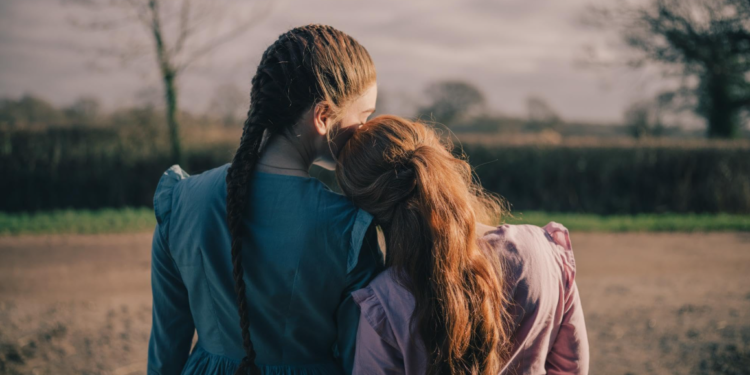Every time that I have seen Louisa Connolly-Burnham’s audacious and quietly powerful film, Sister Wives, I am bowled over by how she strings together emotional tension. This film focuses on one woman centering herself in her own story when the world she inhabits expects her to be obedient, but a fire lit inside her cannot be snuffed out. Once we have sensed the freedom just outside our door, how could we possibly go back to a solitary life where our hearts are restrained?
Connolly-Burnham also stars as Kaidence, a devoted wife to Jeremiah, and they live a quiet, devout life in a shrouded community. We see Kaidence’s back early on, and her tight braid indicates so much to us without having to use dialogue. In the opening scene, Jeremiah returns home and simply says, ‘We are to become three.’ When Kaidence asks him what he means, because they have told each other that they wouldn’t ever give in to having others in their marriage, Jeremiah repeats the line but almost like a question. Jeremiah has thrown this couple into unchartered territory, and Jeremiah asserts himself in a way that Kaidence might not be used to seeing.
“It’s incredible that Jeremiah hasn’t taken another wife yet, because even though we never say how old he and Kaidence are, they are probably in their late twenties or early thirties,” Connolly-Burnham explains. “In this community, he would normally have at least ten wives by now, but they made a promise to each other. They are childhood sweethearts, but, unfortnately, they are having fertility issues and the most important part of this community is to multiply. It’s the only way that these circles have survived for so long, because they breed at such an alarming rate. While there is true love there, I imagine what is happening is that Jeremiah is being emasculated by his dad and his brothers and other members of the church. The pressure is becoming too much, so I think that Kaidence, in a way, knew that this was going to happen.”
Jeremiah quickly marries Galilee, a seemingly doe-eyed young woman who wants to help Kaidence as best she can to make the home better. There is this constant presence of the intersection of faith and intimacy as Galilee takes her place in their home the first night, and Kaidence is shut out of her own bedroom. That intimacy is directly different from when Kaidence and Galilee act on their attraction to one another.

“Both Kaidence and Jeremiah have probably gotten to a place where they are just going through the motions,” she says. “When you see them having sex at the beginning of the film, you can see how methodical and transactional it is and then later, when Jeremiah is saying the prayer before dinner, it doesn’t feel spiritual. It’s not sincere. They are in the rhythm of doing the same thing every day. As far as the intimacy goes between Kaidence and Galilee, I think what’s so exciting about it is that it’s erotic and sensual in a way that Kaidence probably hasn’t experience ina long time.”
When Jeremiah leaves his wives to attend to spiritual business, Kaidence and Galilee are left alone not long after they are brought together. Galilee’s youthful energy is infectious, and her attitudes take Kaidence by surprise. When Galilee reveals that she has a cell phone, Kaidence becomes nervous but she is intrigued. It leads to more open conversations between them as their intimacy grows, but Connolly-Burnham reveals when Kaidence realizes that she can actually trust her younger ward.
“Kaidence softes when she sees the blood on the bedsheets,” she says. “In that moment, she realizes that she shares a lot with Galilee and that Galilee is a victim too. She decides to kind of look after her. Trust is quite a big word. When Galilee has the phone, that’s more about Kaidence being excited and feels alive and she feels like she wants to start taking risks. She hasn’t taken one in ages. When they are having pasta and Galilee asks if Kaidence has ever thought about leaving, Kaidence doesn’t answer. In that moment, I don’t think she fully trusts Galilee yet–maybe she’s worried about being overheard? After that, they have a fun, free day by the river and they try on the red dress and share books by the fire. In that moment, Kaidence turns to Galilee and admits that she has thought about leaving. What’s really beautiful is that same night they make love, and that shows that she trusts her.”
Connolly-Burnham establishes a succint visual language from the very first frame, and the energy becomes looser as that trust grows between these two women. There are steady shots that accentuate the shape of their dresses or their silhouettes. When the women are swimming together, there is a hard cut to a trio of other women watching Kaidence and Galilee being playful together. It is like a bucket of ice water dousing this burgeoning fire, and it quickly reminds us of the world we have entered. Things are strict and structured.
“One of our favorite quotes came from Fleabag,” she says with a laugh. “There’s this wonderful moment where Phoebe Waller-Bridge yells about how “hair is everything,” and here hair is almost like currency. Those three women watching Kaidence and Galilee have hair that is longer than theirs, so I wanted it to be clear this notion of the longer the hair, the better you are. They aren’t allowed to cut it, and it’s this very regimented and uniformed thing that all the women have to look the same. We played a lot with where to cut the scene and we toyed with cutting to their faces or their backs. I wanted to make a film about this group of people becaue I find them so fascinating.
In the FLDS, the reason why they wear pastel colors is because that’s what the men like–to keep them infantalized and pale colors are more childlike. They can’t wear the color red, because the Mormons think that that’s the color that Jesus will be wearing [when he returns] in the Second Coming. A lot of thought went into the color of those dresses, and our costume designer, Constance Woods, made me about 30 swatches for Galilee and 30 for Kaidence. She stuck them all on a bit of paper all dyed in slightly different shades of blues and shades of pink. And we cross-referenced them together. Because we only could afford a certain amount of white dresses, we only had one chance to dye them, and when I saw them on screen, I realized that I wanted them a shade darker. We did that in the grade, but a lot of thought went into those colors.”
 Our conversation turned to real-life comparisons. Queer people still have to hide or change parts of themselves in order to prioritize safety over comfort and happiness, and that could become even harder as a new administration takes hold next month. Connolly-Burnham shares those concerns, but she wanted her film to serve as a beacon.
Our conversation turned to real-life comparisons. Queer people still have to hide or change parts of themselves in order to prioritize safety over comfort and happiness, and that could become even harder as a new administration takes hold next month. Connolly-Burnham shares those concerns, but she wanted her film to serve as a beacon.
“As shocking as what is happening in the world of Sister Wives, I fear that this is going to not be a far cry from the real world,” Connolly-Burnham says, after a moment. “We are going to see more rights stripped from women and queer people, and people watch this film and comment that the way these characters live is so strange to them. I worry about the direction that the world is going in and that this might not be so shocking in a few years.”
Singular, queer joy is in short supply, but the director ends her film on a bold, colorful note. Sister Wives is packed with identifiable imagery, but what could be more daring that a lesbian hopping in the back of a Ford Mustang with her girl by her side, their hair blowing in the wind?
“It was hard to know how to end it, but queer people so rarely get a happy ending in cinema,” she says. “I just want to give the lesbians a happy ending, because short films have, obviously, such a short amount of time. You want to pack a punch. I wanted Kaidence and Galilee to win. And I wanted hope and queer joy. Right now, women aren’t winning, queer people aren’t winning, and I could’ve done something darker and more realistic but I chose not to. Early in the film, Kaidence does Galilee’s hair up and, at the end, Galilee lets Kaidence’s hair down, and I thought that was a lovely symbol to give people hope.”









